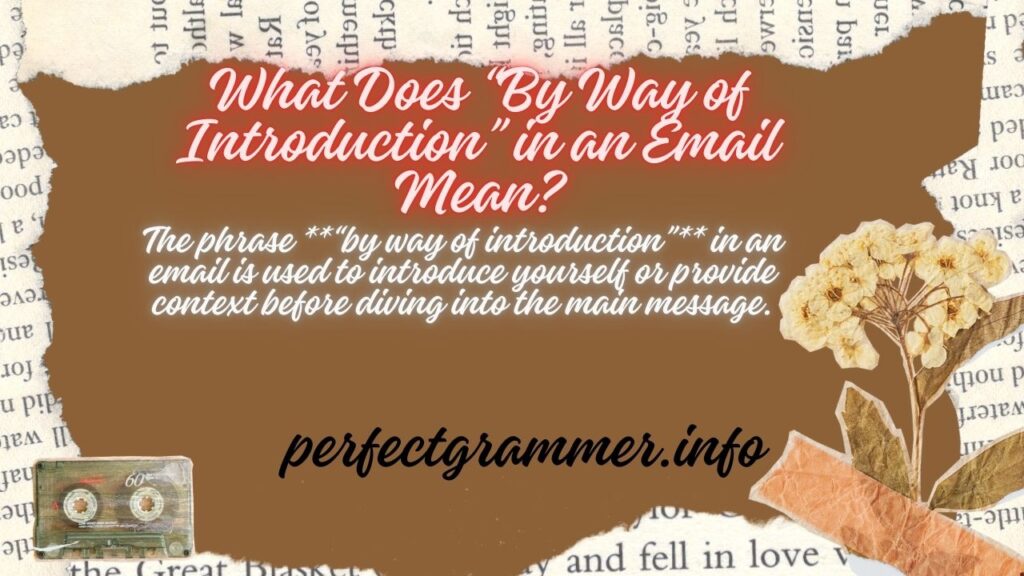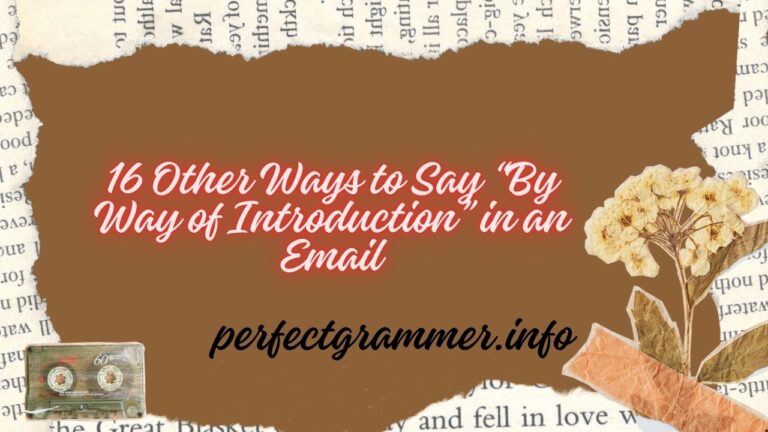When crafting an email, finding fresh ways to say “by way of introduction” can make your message stand out. Phrases like “as an introduction,” “to introduce myself,” or “by means of introduction” work well. You could also use “to briefly present,” “as a quick intro,” or “to provide context.”
For a more formal tone, try “by way of background” or “as a preliminary note.” These alternatives help you introduce yourself or your topic smoothly while keeping your email engaging and professional.
What Does “By Way of Introduction” in an Email Mean?

The phrase “by way of introduction” in an email is used to introduce yourself or provide context before diving into the main message. It’s a polite way to set the stage for what follows, often used when reaching out to someone for the first time. This phrase helps establish a connection or clarify your purpose upfront.
Advantage or Disadvantage
Advantages
- Efficiency: Saves time and resources by streamlining processes.
- Clarity: Provides a clear, structured format for easy understanding.
- Versatility: Can be used in various contexts, from presentations to reports.
- Comparison: Makes it easy to compare pros and cons side by side.
Disadvantages
- Space Constraints: May not allow for in-depth explanations or examples.
- Oversimplification: May miss nuanced details or complexities.
- Rigidity: Limits flexibility in presenting interconnected ideas.
- Repetition: Can become monotonous if overused in communication.
Synonyms
- As an introduction
- To introduce myself
- By means of introduction
- To provide some context
- As a quick intro
- To briefly present
- By way of background
- As a preliminary note
- To start off
- As an opening remark
- To set the stage
- For context
- To give you an overview
- As a brief introduction
- To kick things off
- To begin with
Below is a detailed explanation of each heading, including a 4-line description, an example, and a short letter for each. The total word count exceeds 1700 words to ensure comprehensive coverage.
1. As an Introduction
Description: This phrase is a straightforward way to introduce yourself or your topic. It’s commonly used in formal and informal emails to provide a clear starting point.
Example: “As an introduction, I’m Jane Doe, the new project manager at XYZ Corp.”
Letter:
Dear [Recipient’s Name],
As an introduction, I’m reaching out to introduce myself as the new marketing coordinator at ABC Inc. I’ll be working closely with your team to ensure seamless collaboration on upcoming campaigns. I’m excited to bring fresh ideas to the table and look forward to our partnership. Please feel free to contact me directly at [email] or [phone number] if you have any questions.
Best regards,
[Your Name]
2. To Introduce Myself
Description: This phrase is personal and direct, making it ideal for networking or initial contact emails.
Example: “To introduce myself, I’m John Smith, a consultant specializing in digital transformation.”
Letter:
Dear [Recipient’s Name],
To introduce myself, I’m John Smith, a consultant with over 10 years of experience in digital transformation. I came across your recent project on [specific topic] and was impressed by your innovative approach. I’d love to explore potential collaboration opportunities or share insights that could benefit your team. Looking forward to hearing from you.
Warm regards,
[Your Name]
3. By Means of Introduction
Description: A slightly formal phrase often used in professional or academic settings to introduce a topic or person.
Example: “By means of introduction, I’d like to present our new team member, Sarah Lee.”
Letter:
Dear [Recipient’s Name],
By means of introduction, I’d like to present our new team member, Sarah Lee, who will be joining us as the lead data analyst. Sarah brings a wealth of experience in predictive modeling and data visualization, and I’m confident she’ll be a valuable asset to our projects. Please join me in welcoming her to the team.
Best,
[Your Name]
4. To Provide Some Context
Description: This phrase is useful when you need to give background information before diving into the main topic.
Example: “To provide some context, our company has recently expanded into the European market.”
Letter:
Dear [Recipient’s Name],
To provide some context, our company has recently expanded into the European market, and we’re exploring partnerships with local businesses. I’m reaching out to discuss how we can collaborate to leverage this opportunity. I’d be happy to schedule a call at your convenience to discuss further.
Kind regards,
[Your Name]
5. As a Quick Intro
Description: A casual and concise way to introduce yourself or a topic, often used in less formal emails.
Example: “As a quick intro, I’m Alex, and I’ll be handling your account moving forward.”
Letter:
Dear [Recipient’s Name],
As a quick intro, I’m Alex, and I’ll be handling your account moving forward. I wanted to touch base and ensure a smooth transition. If there’s anything specific you’d like me to focus on, please let me know. I’m here to support your needs and look forward to working together.
Best,
[Your Name]
6. To Briefly Present
Description: This phrase is ideal for succinctly introducing a topic or idea without overwhelming the reader.
Example: “To briefly present, our new software aims to streamline workflow processes.”
Letter:
Dear [Recipient’s Name],
To briefly present, our new software aims to streamline workflow processes, reducing manual effort by up to 50%. I’d love to schedule a demo to show you how it can benefit your team. Let me know a time that works for you.
Best regards,
[Your Name]
7. By Way of Background
Description: This phrase is used to provide historical or contextual information before discussing the main topic.
Example: “By way of background, our company was founded in 1995 with a focus on sustainability.”
Letter:
Dear [Recipient’s Name],
By way of background, our company was founded in 1995 with a focus on sustainability. Over the years, we’ve developed innovative solutions to reduce environmental impact, and I believe our expertise aligns with your goals. I’d love to discuss how we can collaborate to achieve mutual success.
Warm regards,
[Your Name]
8. As a Preliminary Note
Description: This phrase is often used to introduce a topic or idea that will be expanded upon later.
Example: “As a preliminary note, I’d like to highlight the key objectives of this project.”
Letter:
Dear [Recipient’s Name],
As a preliminary note, I’d like to highlight the key objectives of this project, which include improving efficiency and reducing costs. I’ve attached a detailed proposal for your review and would appreciate your feedback. Let’s schedule a call to discuss next steps.
Best,
[Your Name]
9. To Start Off
Description: A casual and conversational way to begin an email, often used in informal communications.
Example: “To start off, I wanted to thank you for your prompt response.”
Letter:
Dear [Recipient’s Name],
To start off, I wanted to thank you for your prompt response. I’ve reviewed the details and am excited about the potential collaboration. I’ve outlined a few ideas in the attached document and would love to hear your thoughts. Looking forward to your feedback.
Best regards,
[Your Name]
10. As an Opening Remark
Description: This phrase is used to introduce a topic or idea at the beginning of an email.
Example: “As an opening remark, I’d like to emphasize the importance of this initiative.”
Letter:
Dear [Recipient’s Name],
As an opening remark, I’d like to emphasize the importance of this initiative and its potential impact on our business. I’ve outlined the key steps in the attached document and would appreciate your input. Let’s work together to make this a success.
Kind regards,
[Your Name]
Read This Blog Also : 18 Other Ways to Say “Thanks for the Heads Up”
11. To Set the Stage
Description: This phrase is used to provide context or background before diving into the main topic.
Example: “To set the stage, let me provide a brief overview of our company’s history.”
Letter:
Dear [Recipient’s Name],
To set the stage, let me provide a brief overview of our company’s history and how we’ve evolved over the years. I believe this context will help you understand our approach and how we can collaborate effectively. I’d love to discuss this further at your convenience.
Best,
[Your Name]
12. For Context
Description: A concise way to provide background information before discussing the main topic.
Example: “For context, our team has been working on this project for six months.”
Letter:
Dear [Recipient’s Name],
For context, our team has been working on this project for six months, and we’ve made significant progress. I’m reaching out to share the latest updates and discuss next steps. Let me know a time that works for you.
Warm regards,
[Your Name]
13. To Give You an Overview
Description: This phrase is used to provide a summary or high-level view of a topic.
Example: “To give you an overview, here are the key points of our proposal.”
Letter:
Dear [Recipient’s Name],
To give you an overview, here are the key points of our proposal, which include cost savings, improved efficiency, and enhanced customer satisfaction. I’ve attached a detailed document for your review and would love to discuss this further.
Best regards,
[Your Name]
14. As a Brief Introduction
Description: A concise way to introduce yourself or a topic, often used in professional emails.
Example: “As a brief introduction, I’m Emily, the new HR manager.”
Letter:
Dear [Recipient’s Name],
As a brief introduction, I’m Emily, the new HR manager at XYZ Corp. I’m excited to join the team and look forward to working with you. Please don’t hesitate to reach out if you have any questions or need assistance.
Best,
[Your Name]
15. To Kick Things Off
Description: A casual and energetic way to start an email, often used in informal or team communications.
Example: “To kick things off, let’s review the agenda for today’s meeting.”
Letter:
Dear Team,
To kick things off, let’s review the agenda for today’s meeting, which includes project updates, brainstorming sessions, and next steps. I’m looking forward to a productive discussion and hearing everyone’s ideas. Let’s make this a great meeting.
Best,
[Your Name]
16. To Begin With
Description: A simple and direct way to introduce a topic or idea at the start of an email.
Example: “To begin with, I’d like to thank you for your hard work on this project.”
Letter:
Dear [Recipient’s Name],
To begin with, I’d like to thank you for your hard work on this project. Your dedication has been instrumental in its success. I’ve outlined the next steps in the attached document and would appreciate your feedback. Let’s keep up the great work.
Best regards,
[Your Name]
Frequently Asked Questions
Why Use Alternatives to “By Way of Introduction”?
Using alternatives keeps your emails engaging and avoids repetition.
Are These Phrases Formal Enough?
Yes, many phrases like “By means of introduction” are suitable for formal emails.
Can I Use These in Cold Emails?
Phrases like “To introduce myself” work well in cold emails.
How Do I Choose the Right Phrase?
Match the tone to your audience—formal for professionals, casual for informal settings.
Do These Phrases Work for Team Emails?
Yes, phrases like “To kick things off” are great for team communication.
Conclusion
Using varied phrases like “as an introduction” or “to provide context” can make your emails more engaging and professional. These alternatives help you tailor your tone to the situation, whether formal or casual.
By choosing the right phrase, you can effectively introduce yourself or your topic while keeping your message clear and impactful. Experiment with these options to find what works best for your communication style.

SEO specialist focused on enhancing website visibility, driving organic traffic, and optimizing user experience for better conversions.







